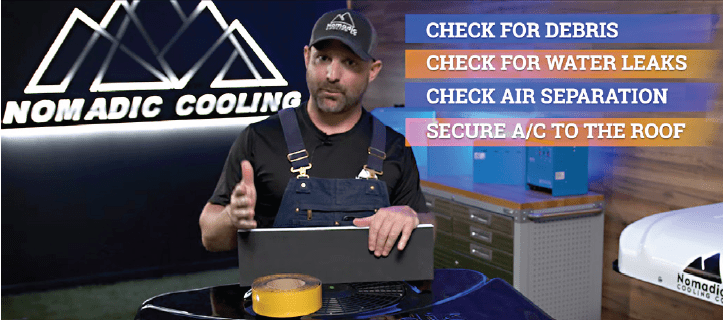At Nomadic Cooling, your comfort and safety are of paramount importance to us as you embark on your thrilling journeys. As travelers, we are often so excited for the adventure ahead that we can forget to check out our systems before we head out.
While RV air conditioners boast durability, they are not impervious to wear. Over time, their cooling prowess may wane, necessitating replacement. But with regular maintenance, you can prolong your AC unit’s lifespan and sustain peak performance. Minor repairs may arise, and any time you have questions, our committed technical support team is standing by at (480) 576-2489.
Our knowledgeable staff will walk you through the troubleshooting process and then guide you through the repair or replacement necessary. Most problems can be resolved with phone and email exchanges. For hands-on assistance you can always call ahead and visit our shop in Glendale, AZ. You may also consult any of the
endorsed upfitters provided on our website (scan the QR code).

Exterior Maintenance:
- Get up close and personal. Grab a ladder and climb up so that you can see your AC unit from all angles.

- Check to make sure that your AC unit’s shroud (the outer plastic cover) is free of cracks or splits. The sun is very harsh and can cause damage to your cover, as can hail or low hanging branches encountered during your overland adventures.
TIP:.
For winterizing, or just keeping your rig parked for extended periods, consider a Nomadic Cooling AC cover. These perfect fit covers not only provide an extra layer of protection from the sun and elements, but also prevents debris from getting into your air conditioner.

- Check your AC unit to make sure that it is still securely mounted to your roof. Depending on the type of traveling you do, nuts and bolts can loosen. It is a good idea to recheck for security.
- Carefully remove the shroud bolts and inspect each one for wear. Once the shroud is removed, you should inspect all the AC unit components. It is most important to check the tightness of all screws and bolts, and make sure all wires are tightly connected. When checking wires, add gentle pressure while pulling on them to make sure that they do not easily pop out of their connections.
- Check the fuse, and look for any rusted areas.
- Nomadic Cooling AC units are built so that NO moisture should leak into your rig. Water getting into the internal workings of your AC unit can shorten the lifespan of your air conditioner. Water also follows the roof rafters which can cause damage to your vehicle’s ceiling or walls. The usual culprit with leaks is the sealant around the external opening in your roof. Sealant can break down over time, so it is important to check it, especially after cold winter weather. Pour water around the edge of the AC unit and look for any drips inside your rig. If necessary, carefully remove the old sealant, make sure the surface is fully dry and then reseal with the appropriate sealant (we recommend BetaSeal®).


- Look for potential water build up in the water channels along the bottom of the AC unit. You will see where water can collect (from weather, washing, etc.) and you can see that the water follows along a channel and then drips out the sides of the AC unit through small square or u-shaped cutouts. Make sure that these channels and cutouts are free of debris or build up of minerals. You can use a small bristle brush or compressed air to clean these areas out.


- The condenser coil (under the back fan) should be inspected and cleaned if any debris has built up on it. If it needs cleaning, use a canister of compressed air. Blow the air onto the coil through the fan opening. Use an extension to get the nozzle close to any stubborn dirt.

- If compressed air can’t remove all of the buildup, you can use water, or a solution of water with a tablespoon of white vinegar. A little baking soda helps to remove any grease. You can also add a few drops of dishwashing detergent to your solution.
- Use a spray bottle to reduce spillover onto your vehicle’s rooftop or sides. Have a few towels on hand to soak up any excess water. Spray the condenser coils and let it sit for about 5 minutes before giving them a fresh water rinse.
- There are AC unit spray cleaners available that don’t require rinsing.
- You can safely use soft bristle brushes on the condenser coils. Never use a metal or wire brush even if it is advertised as an AC condenser coil brush. Metal brushes can damage the condenser coils.

- Nomadic AC units do not require the evaporator (smaller) coils to be inspected or cleaned. Our evaporator covers completely seal off the evaporator from the rest of the world, prevents any build-up of dirt, grease or other debris on the evaporator coils.
- If you have a RV maintenance or RV shop nearby, you should also have your coolant level checked at least once per year.

WARNING:
- Allow the AC unit to completely dry (30-60 minutes) before reconnecting the power and turning it on.
- Do not use Lysol or other bathroom sanitizers to clean your AC unit’s return vents. A high ethanol alcohol or acetate concentration makes them highly flammable.
Interior Maintenance:
- Interior maintenance starts with vacuuming the outside of the faceplate with attention given to the intake and outtake air vents.

- Gently unscrew the faceplate from your ceiling and carefully lower it so that you do not let the faceplate fall that could create damage to the LED control panel or its wire harness. Inspect the inside with a flashlight, looking for any loose wires, burnt or melted wires, or debris. Inspect your positive (red) and negative (black) cables for any damage to them. Carefully vacuum the inside removing dust, debris, pet hair, etc. Avoid hitting the LED panel or dislodging any of the wire connections with your vacuum hose. The LED control panel is delicate and expensive to replace, as it is the “brain” of your AC unit.

- Gently tug on the molex and other connectors on the LED control panel. These are inexpensive and relatively easy repairs to make. Loose connections will often get extremely hot. Prevention through good maintenance is key and routinely checking these connections to make sure they are tight is imperative.
- Check to make sure that the air separator foam is properly and securely in place. Improper air separators can cause condensation and reduce cooling capacity.

- Always have spare fuses on-hand for your AC unit and electrical system when you travel. After you troubleshoot the reason they are blowing, you will have them to replace quickly. NEVER use auto-resetting fuses. If a fuse continues to fail, investigate the problem before replacing it again. This is also true with breakers that continue to trip. If you aren’t sure why a breaker tripped or keeps tripping, investigate the circuit.


- Once you are comfortable with your internal inspection, carefully screw the faceplate back onto the ceiling. Ensure the AC unit has dried completely, and then start up your AC unit. It is important to know the amps it is drawing. It is vital to ALWAYS be aware of your power usage. It is our recommendation that you have a breaker between the AC unit and the power source, both for your safety and for preventing damage from a surge to the AC unit.
- Adequate amperage to your AC unit from the power supply ensures that it always runs correctly, cools your space effectively, and prevents damage to the AC unit. There are multiple power options available on the market, but not all are appropriate for our AC units. When in doubt, give our technical support team a call to work through the logistics of your system. Our team has worked with many different power options for our AC units and can help you determine what will work best to safely supply the correct amperage to your AC unit.
- The air filter is permanently affixed inside of the AC unit. It can be inspected through the outtake ducts. Use compressed air to remove any debris or build up you see on the filter.
TIP:
Lastly, keep track of your maintenance or repairs on your AC unit. This not only keeps you on top of your unit, but will help increase the longevity of the unit, maintain your comfort for safe journeys, and increase resale value. A good rule of thumb with all RV, van and overland rigs is to thoroughly check your AC unit, appliances, and electrical systems before you head out on the road. Repairs and replacements are not always a quick fix. They often take time, but working side-by-side with our support staff is the surest and fastest way to work out any problems, address any issues, or relieve any concerns you may have about the safe and optimal operation of your Nomadic Cooling AC unit.

Email office@nomadiccooling.com and we can send you a copy!





